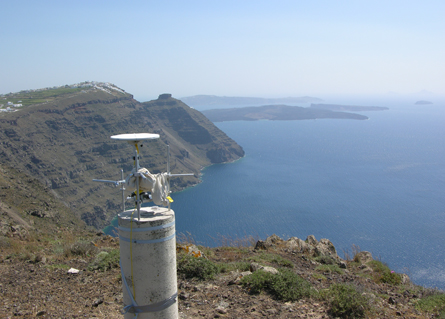- More than 2 years ago
The Greek islands of Santorini, site of one of history’s most colossal volcanic eruptions, are rumbling again.

Since January 2011, earthquakes have shaken the landscape and the Santorini volcano’s surface has lifted by about 140 millimeters — possibly because magma is rising from the deep and filling an underground chamber, scientists report in an upcoming Geophysical Research Letters.
It’s far from certain whether Santorini will erupt, the researchers say. Even if it does, the eruption won’t be anything like the infamous blast that occurred around 1600 B.C., says Andrew Newman, a geophysicist at the Georgia Institute of Technology in Atlanta. That eruption showered ash across the eastern Mediterranean, possibly contributing to the decline of the Minoan civilization and perhaps giving rise to the legend of the lost city of Atlantis.
“We do not think a Minoan-type eruption is likely,” Newman says.
If Santorini does erupt, it will probably be a small eruption like those seen there over the past few hundred years, most recently in 1950. Those eruptions have built up a pair of islands in the center of the now-drowned remains of the volcano, or caldera.
Newman and his colleagues, including several at the University of Patras in Greece, began studying Santorini in 2006. They set out Global Positioning System stations that precisely monitor tiny movements in the surface and can capture the volcano inflating as if taking a deep breath. The landscape moved barely at all until early 2011, when it suddenly awoke.
The amount of movement is consistent with a blob of magma about three football fields wide rising into a chamber and swelling the crust about four kilometers beneath Santorini, Newman says. “If we really start identifying that the source is migrating and becoming more shallow with time, then the hazard may increase,” he says.
Other calderas have shown similar inflation and earthquake swarms before without erupting. In the early 1980s, the town of Pozzuoli, Italy, rose nearly two meters but the Campi Flegrei caldera beneath it did not erupt, says Tim Druitt, a volcanologist at the Blaise Pascal University in Clermont-Ferrand, France. “Only about 10 percent of cases of such unrest at calderas result in eruption.”
Greek officials have convened an expert committee to study how the volcano should be monitored. The committee head, Kosmas Stylianidis of the Aristotle University of Thessaloniki in Greece, says the group will continue to keep an eye on the current unrest. But for now the scientists won’t issue any specific alerts before they meet in Santorini on March 27.






